| Austria |
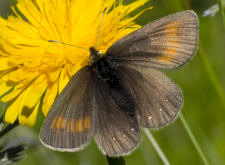 White Speck Ringlet Erebia claudina White Speck Ringlet Erebia claudina
Found at high altitude only in the Austrian Alps.
|
|
| Bulgaria
(click here for more info) |
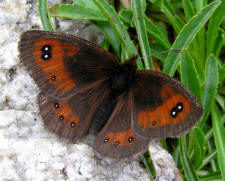
Nicholl's
Ringlet Erebia
rhodopensis
A mountain species occurring locally on alpine and sub-alpine grassland. |
Summary
Bulgaria is a relatively small and mountainous country (111,000 sq km)
in the far south-east of Europe (bigger than Scotland, smaller than
England). It is rich in wildlife and wild places with nearly 34% of the
country designated under the Natura 2000 network. This includes 50
Prime Butterfly Areas. It is one of the butterfly hotspots of Europe
with 216 species reliably recorded there (210 breeding species),
including many species that are widespread in Europe (including
virtually all those that occur in the UK). It has the highest mountains
in the Balkans which host a range of high altitude species, including
14 species of Erebia. It has two near endemics as well as another 5
species that are endemic to the Balkans while another 17 species only
occur in the Balkans in Europe.
|
| Cyprus
(click here for more info) |
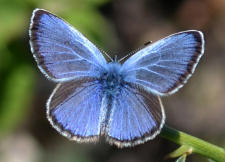 Paphos
Blue Glaucopsyche paphos
Paphos
Blue Glaucopsyche paphos
Endemic & widespread within Cyprus.
|
Summary
Although a relatively large island (9253 km2) the location of Cyprus on
the crossroads of Europe and Asia, 70 km from the nearest mainland
country
(Southern Turkey) and with a typically arid eastern Mediterranean
summer climate, combine to restrict the number of confirmed butterfly
species to 52 although not all are resident.
Recording
This is run by Eddie John FRES from the UK, with Distribution Maps
maintained at a resolution of 5 x 5 km and 10 x 10 km UTM squares.
Eddie will be pleased to provide a map showing the grid squares to
enable accurate placement of sightings. Assistance with identification
is available if required.
Contact: eddiejohn100@gmail.com
Website: http://www.cyprusbutterflies.co.uk/page3.html
|
| France |
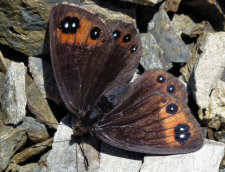
Lefebvres
Ringlet Erebia lefebvrei
Found on Pyrenean scree slopes. Foodplants are various
fescues and meadow grasses. |
Summary
France is home to 260 butterfly species with 26 of them considered
threatened in Europe. France
has 26 Prime Butterfly Areas principally located in a belt stretching
from Bordeaux across to the Alps
with only two PBA’s in the north and one in Corsica.
The country is vast and varied with a rich butterfly fauna. We
have asked a number of local experts to contribute information about
their particular area and have already received the following
contributions. Please contact us if you wish to assist by adding
information on other areas of France.
The following links will open PDF's reviewing each respective
region.
Recording
National Action Plan 2018 - 2028 Butterflies
of France. See pages 10 & 11 for priority lists
Red List of Butterflies ~ France
Regional
Red Lists
|
| Germany
(click here for more info) |
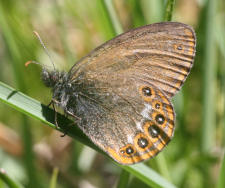
Scarce
Heath Coenonympha hero
Some of the few remaining western European populations of this glacial
relict species are in Germany. |
Summary
Almost
all of the butterfly fauna of north-west Europe (outside the Alps) are
present in Germany, although many of the more specialist species are
rare and/or endangered there. More then 180 butterfly species
are
native to Germany, of which three (Violet Copper (Lycaena
helle),
Large Blue (Phengaris arion) and False Ringlet Coenonympha oedippus))
are classified as endangered in Europe.
Recording
Germany
Species List/Protection Status - Download
Here (Zipped Excel file - 13kb) |
| Greece
(click here for more info) |
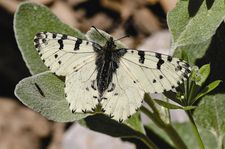
Cretan
Festoon Zerynthia
cretica
Habitat of dry, open scrub, the larval food plant is Birthwort
Aristolochia
cretica, which only grows on Crete.
|
Summary
Greece has about 232 species of butterfly and one of the richest
butterfly faunas of any country in Europe with its own endemic species
and many species with their European distribution largely restricted to
Greece. The Greek
mainland, particularly the mountains, are of greatest interest for
butterflies
though there are specialised endemic species on many of the islands
including Crete e.g. Cretan
Festoon (Zerynthia cretica).
The season is very long with butterflies on the wing from February to
November.
|
| Hungary
(click here for more info) |
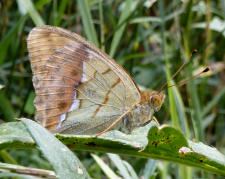
Pallas's
Fritillary Argynnis
laodice
Found in damp forests where the larva feed on viola species. |
Summary
Hungary originally had about 170 butterfly species but the present
number ofspecies is just over 160 due to extinctions as a result of
changes in landscape use and drainage of wetlands in the late 19th and
early 20th centuries. The butterfly fauna of Hungary is typical Central
European with a number of Mediterranean elements (such as Nettle-tree
Butterfly, Cardinal, Iolas Blue or even occasional specimens of
Long-tailed Blue). Penetration of Atlanto-Mediterranean species (e.g.
Red Underwing Skipper) and Siberian elements
(Yellow-legged Tortoiseshell, Pallas’s Fritillary) occur mainly in the
north-western and northeastern
regions). The butterfly and moth season begins at the end of March and
lasts until November.
|
| Italy
(click here for more info) |
Piedmont
Anomalous Blue
Polyommatus
humedasae
Endemic to Italy, inhabits Aosta valley in the Italian Alps. |
Summary
Italy (including the islands of Sardinia and Sicily) has a rich and
varied landscape and vegetation. It is home to over 260 resident
species with around 20 Italian endemics and Italy has more Prime
Butterfly Areas (32) than any other European country.
|
| Macedonia |
Macedonian
Grayling Pseudochazara
cingoski
Found amongst limestone rocks.
|
|
| Portugal |
Portuguese
Dappled White Euchloe
tagis
Found on hot, dry rocky hillsides, unusually on limestone, with patches
of scrub & clumps of tall grass.
|
Butterflies
of the Iberian Peninsula by Paul R. G. Browning
Paul Browning's book 'Butterflies of the Iberian Peninsula' is
comprehensive, accurate and contains a wealth of information on the
butterflies of Spain and Portugal. See the EBG Species page for
more
information and download.
|
| Romania |
Danube
Clouded Yellow Colias
myrmidone
Endangered, feeds on broom sp.
|
|
| Slovenia
(click here for more info) |
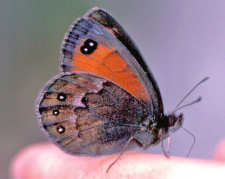
Stygian
Ringlet Erebia
styx
Found on dry limestone slopes of the Julian Alps where it feeds on
grasses. |
Summary
Slovenia is a small country - about the same size as Wales - with a
remarkable variety of habitats. The highest point is in the Julian Alps
- Mount Triglav, at 2863 metres. River valleys run mainly SE towards
the Danube, reaching the Pannonian plain just before exiting Slovenia.
This part still has areas of wet grassland and floodplain woodland. The
dinaric karst region has a variety of meadows, hillsides and forests,
and is rich in orchids and butterflies. The Mediterranean coastline
stretches for only 46km between Italy and Croatia, but has its own
attractions for the naturalist. With 179 confirmed species, Slovenia is
perfect destination for anyone interested in butterflies.
|
| Spain
(click here for more info) |
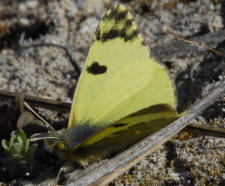
Spanish
Greenish Blacktip
Euchloe bazae
A Spanish endemic of 2 sub-species.
|
Summary
Peninsular Spain and the Balearic Islands are home to between 232
and 239 species of butterfly (depending on the source consulted).
The Canary Islands are home to around 600 species of Lepidoptera, more
than
a quarter of which are found nowhere else in the world.
Butterflies
of the Iberian Peninsula by Paul R. G. Browning
Paul Browning's book 'Butterflies of the Iberian Peninsula' is
comprehensive, accurate and contains a wealth of information on the
butterflies of Spain and Portugal. See the EBG Species page for
more
information and download.
|
| Sweden |
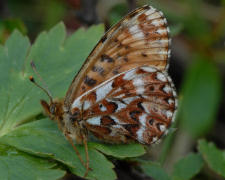
Freija’s
Fritillary Boloria
freija
A species confined to Scandinavia but not uncommon.
|
|
| Switzerland
(click here for more info) |
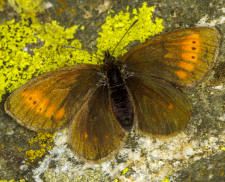
Eriphyle
Ringlet Erebia
eriphyle
Local species of grassland in the Alps.
|
Summary
Switzerland is one of the biodiversity hot spots of Europe being
blessed with roughly 208 species. A large percentage of the surface
area of Switzerland is dominated by high mountains and its fauna is
greatly enriched by its Alpine representatives. It also benefits from
some Mediterranean influences around in the S and SW. Switzerland has
no endemic species although is home to several extremely local and
restricted species shared with neighbouring Italy and/or Austria. Some
of Europe's central European species are represented at low to mid
altitudes, including some of the wetland specialists.
|
| Turkey
(click here for more info) |
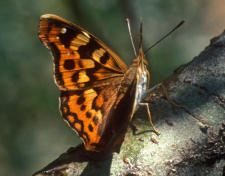
Ionian
Emperor Thaleropis
ionia
A species of river valleys & woodland from Southern and Eastern
Turkey. |
Summary
For watching butterflies, Turkey is hard to beat. Its famously rich
flora provides a huge range of foodplants and nectar sources for
butterflies, and its mix of temperate and dry, cold and hot climates
are perfect for a wealth of species – from Europe, Asia, the Middle
East and Africa. On top of all this, there are also many species that
are unique to Turkey. The famous ‘biogeographic crossroads’ give Turkey
a staggering diversity of butterflies – around 380 species, more than
40 of them endemic. |
 Countries
Countries